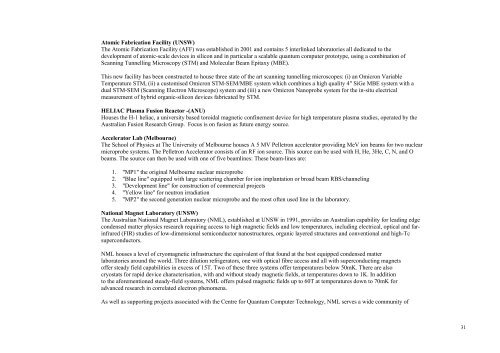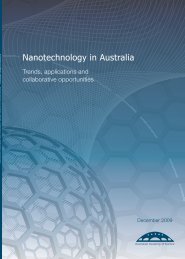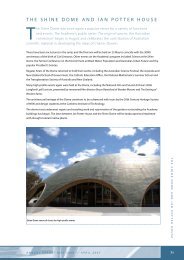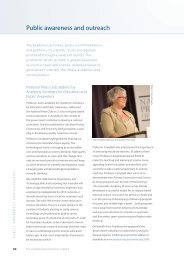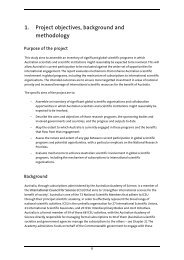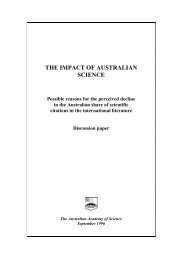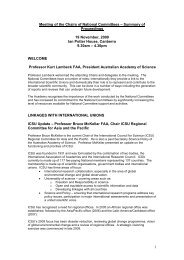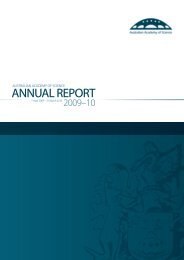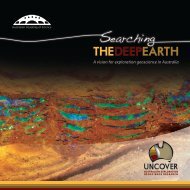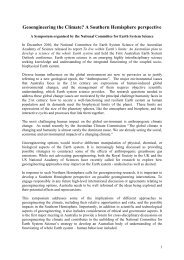Australia's Major National Research Facilities - Australian Academy ...
Australia's Major National Research Facilities - Australian Academy ...
Australia's Major National Research Facilities - Australian Academy ...
Create successful ePaper yourself
Turn your PDF publications into a flip-book with our unique Google optimized e-Paper software.
Atomic Fabrication Facility (UNSW)<br />
The Atomic Fabrication Facility (AFF) was established in 2001 and contains 5 interlinked laboratories all dedicated to the<br />
development of atomic-scale devices in silicon and in particular a scalable quantum computer prototype, using a combination of<br />
Scanning Tunnelling Microscopy (STM) and Molecular Beam Epitaxy (MBE).<br />
This new facility has been constructed to house three state of the art scanning tunnelling microscopes: (i) an Omicron Variable<br />
Temperature STM, (ii) a customised Omicron STM-SEM/MBE system which combines a high quality 4" SiGe MBE system with a<br />
dual STM-SEM (Scanning Electron Microscope) system and (iii) a new Omicron Nanoprobe system for the in-situ electrical<br />
measurement of hybrid organic-silicon devices fabricated by STM.<br />
HELIAC Plasma Fusion Reactor -(ANU)<br />
Houses the H-1 heliac, a university based toroidal magnetic confinement device for high temperature plasma studies, operated by the<br />
<strong>Australian</strong> Fusion <strong>Research</strong> Group. Focus is on fusion as future energy source.<br />
Accelerator Lab (Melbourne)<br />
The School of Physics at The University of Melbourne houses A 5 MV Pelletron accelerator providing MeV ion beams for two nuclear<br />
microprobe systems. The Pelletron Accelerator consists of an RF ion source. This source can be used with H, He, 3He, C, N, and O<br />
beams. The source can then be used with one of five beamlines: These beam-lines are:<br />
1. "MP1" the original Melbourne nuclear microprobe<br />
2. "Blue line" equipped with large scattering chamber for ion implantation or broad beam RBS/channeling<br />
3. "Development line" for construction of commercial projects<br />
4. "Yellow line" for neutron irradiation<br />
5. "MP2" the second generation nuclear microprobe and the most often used line in the laboratory.<br />
<strong>National</strong> Magnet Laboratory (UNSW)<br />
The <strong>Australian</strong> <strong>National</strong> Magnet Laboratory (NML), established at UNSW in 1991, provides an <strong>Australian</strong> capability for leading edge<br />
condensed matter physics research requiring access to high magnetic fields and low temperatures, including electrical, optical and farinfrared<br />
(FIR) studies of low-dimensional semiconductor nanostructures, organic layered structures and conventional and high-Tc<br />
superconductors.<br />
NML houses a level of cryomagnetic infrastructure the equivalent of that found at the best equipped condensed matter<br />
laboratories around the world. Three dilution refrigerators, one with optical fibre access and all with superconducting magnets<br />
offer steady field capabilities in excess of 15T. Two of these three systems offer temperatures below 50mK. There are also<br />
cryostats for rapid device characterisation, with and without steady magnetic fields, at temperatures down to 1K. In addition<br />
to the aforementioned steady-field systems, NML offers pulsed magnetic fields up to 60T at temperatures down to 70mK for<br />
advanced research in correlated electron phenomena.<br />
As well as supporting projects associated with the Centre for Quantum Computer Technology, NML serves a wide community of<br />
31


